Episodes of Lake Marathon 13: Shirgaon Mangroves
13th Episodes of Lake Marathon in mangroves forest! That sounds like a wonderful way to spend a Thursday morning! Mangroves are often rich ecosystems, and bird watching can be a peaceful and rewarding activity. Rathnagiri in India is known for its natural beauty, and exploring the mangroves must have provided a unique experience. Did you happen to spot any specific bird species or have any memorable moments during your bird-watching excursion?
Sunrise captured on the Shirgaon Mangroves
Starting your birdwatching cycle post sunrise sounds like a fantastic way to witness the beauty of nature unfolding. Sunrises can indeed be breathtaking, casting a warm glow and creating a serene atmosphere. Observing birds against the backdrop of a beautiful sunrise adds an extra layer of magic to the experience.
Exploring mangroves for the first time is a unique and educational experience. Witnessing the viviparity of Rhizophora, where the plants produce seeds that germinate while still attached to the tree, is a fascinating aspect of mangrove ecosystems. Mangrove plants have evolved various adaptations, including breathing roots, to thrive in the challenging conditions of intertidal zones.
The breathing roots, often called pneumatophores, help mangrove trees survive in waterlogged soils by allowing them to access oxygen. It's incredible to see how these plants have adapted to their environment. Mangroves play a crucial role in coastal ecosystems, providing habitat for various species and acting as a buffer against storms and erosion.
Pneumatophores or breathing roots
Mangrove plants.
Mangrove water body
Avifauna: There were number of colourful birds but only a few of them were documented during my short visit.
Note: Some bird pictures may not be clear as it was captured from a far off place.
1. Red Vented Bulbul: There are plenty of bulbuls of different species, I could spot red vented bulbul and red whiskered bulbul for the first instance. Observing bulbuls in the mangrove forest adds a delightful touch to your birdwatching experience.
Red Vented Bulbul
2. Red Whiskered bulbul: I have spotted red whiskered bulbul in almost all the lakes I have visited. These bulbuls are not only visually striking but also contribute to the biodiversity of the mangrove ecosystem. They play a role in seed dispersal and insect control, contributing to the overall health of the environment.
Red Whiskered Bulbul
3. Spotted Dove: Seeing one perching on a cable wire adds a charming touch to the avian scene. These doves are known for their gentle cooing calls and are often found in a variety of habitats, including urban areas. Observing birds in different settings, whether it's a mangrove forest, a lakeside, or even urban environments, highlights the adaptability of these creatures.
Spotted Dove
4. The Asiatic green bee-eater: It is a striking bird with its vibrant green plumage and elongated central tail feathers. Spotting one perching on a cable wire must have been a visually captivating moment. These bee-eaters are often found in a variety of habitats, including open areas, farmland, and urban environments.
Asiatic Green Bee Eater
5. Common Iora: I am spotting this bird for the first time in the episodes of the lake marathon. It is a small and colorful bird, and spotting one perched on a tree branch adds to the beauty of your birdwatching experience. These birds are known for their distinctive yellow and black plumage, with the male having a brighter yellow coloration compared to the female. They are often found in wooded habitats, including forests, gardens, and orchards. They are known for their melodious calls and agile movements as they forage for insects among the foliage.
Common Iora
6. White Browed Bulbul: I am seeing this species for the first time in the lake marathon. It is known for its distinctive white eyebrow stripe, adding a subtle contrast to its overall plumage. Spotting one hiding amidst the tree branches must have required a keen eye, as these birds can sometimes blend in with their surroundings. The white-browed bulbul's ability to conceal itself in the foliage is a clever adaptation for avoiding predators and, at times, for more effective hunting.
7. Ashy Prinia: Found an ashy prinia on the ground. It is a small, active bird known for its distinctive appearance with ashy-gray plumage and a rufous-brown crown. Their presence on the ground might be related to their feeding habits, as they search for prey among the grasses and foliage.
Ashy Prinia
8. Rosy Starling: The presence of a bunch of rosy starlings in shrubs and trees is quite a spectacle! Previously I had seen this species in Bogadi Kere, Mysore. Rosy starlings are known for their striking pink and black plumage, especially during the breeding season when the males display vibrant colors.
These birds are highly social, and observing them in a group can be quite mesmerizing. They often forage on the ground for insects and fruits and are known for their acrobatic flight patterns. The contrast of their rosy pink feathers against the greenery must have been a beautiful sight.
Rosy Starling
9. Black Drongo: Spotting them in the mangrove forest adds a dynamic element to the avian landscape. Black drongos are known for their aerial acrobatics and are often seen perched prominently or flying with agility to catch insects mid-air. They are highly adaptable birds and can be found in various habitats, including mangroves.
10. Oriental Magpie: An oriental magpie was found admits the tree branches. The Oriental magpie-robin is a charming bird with its black and white plumage, often accompanied by a long, elegant tail. Oriental magpie-robins are commonly found in a variety of habitats, including gardens, parks, and wooded areas. They are agile and often seen hopping around branches and foraging on the ground for insects.
11. Small Blue Kingfisher: Observing this small blue kingfisher searching for prey was a wonderful and dynamic sight. The vivid blue plumage of kingfishers, combined with their rapid and precise movements, makes them standout characters in their natural habitats.
Common Kingfisher/Small Blue Kingfisher
12. Little Cormorants: Spotting little cormorants is always an interesting find during birdwatching. These water birds are known for their dark plumage and distinctive long necks. They are often seen near water bodies like lakes, ponds, or mangroves, as they are excellent divers and primarily feed on fish. After a dive, cormorants can be seen perching with outstretched wings, a behavior known as wing drying, as their feathers are not as waterproof as those of some other water bird species.
Little Cormorant
13. Western Reef Heron (Grey phase & White phase): Seeing this species for the first time in the lake marathon. I couldn't identify this bird and had to take help of Mr. Chinmay Sawanth (Local Bird Watching Expert).
It is a medium-sized heron found in coastal areas, including mangroves, estuaries, and shallow coastal waters. Observing a Western Reef Heron, especially in its white morph, can be a visually striking experience. They are skilled hunters, feeding on fish, crustaceans, and other aquatic prey. Their behavior often involves patiently stalking their prey and striking with a swift and precise motion. For the first, I thought that these 2 birds are of different species, later on I learnt that they are 2 different colour morphs of the same species.
Grey Phase White Phase
Dark Morph (Gray Phase): The dark morph is characterized by slate-gray or dark plumage. They have a long, slender bill and yellow legs.
Western Reef Heron - Dark Morph
White Morph (White Phase): The white morph, on the other hand, is mostly white, with occasional dark markings on the wings and back. The bill is usually dark, and the legs are yellow.
Western Reef Heron - White Morph
15. Common Myna: Found some common mynas foraging on the grounds. Observing Common Mynas in the mangrove region indicates their adaptability to diverse environments.
16. Red Wattled Lapwing: Like in the other lakes, lapwings were found in good number in the mangrove region as well. This indicates the diverse adaptability of lapwings. Couldn't capture any pic of them, yet to be documented as they were found in good number.
Invertebrates of Shirgaon Mangroves:
The presence of bivalves, snails, and crabs in the mangrove region adds to the overall biodiversity of this unique ecosystem. Mangroves are coastal ecosystems that provide a transition zone between land and sea, characterized by the presence of salt-tolerant trees, shrubs, and various aquatic species. Bivalves play a crucial role in nutrient cycling and water filtration in mangrove ecosystems.
Snails: Mangroves often host various species of snails, which contribute to nutrient cycling and play a role in the decomposition of organic matter. They are important members of the mangrove food web and are prey for many other organisms.
Crabs: Mangroves are known for supporting diverse crab populations. Fiddler crabs, mud crabs, and other species are commonly found in mangrove habitats. Crabs play a vital role in nutrient cycling, burrowing activities, and as a food source for birds and larger predators.

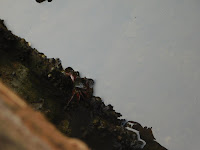
Flower Crab
Fidler crabs
Ant nest on a mangrove tree
Ant hill
Flora of Shirgaon Mangroves: Found Sonneratia alba during the mangrove exploration. Sonneratia alba, commonly known as the Milkbush Mangrove or Apple Mangrove, is a species of mangrove tree belonging to the family Lythraceae. This mangrove species is well-adapted to saline environments and is typically found in muddy or sandy coastal areas, often forming dense stands in mangrove swamps. It plays a crucial role in stabilizing coastal areas, preventing erosion, and providing habitat for a variety of organisms. The dense root systems of mangroves contribute to the overall resilience of coastal ecosystems.
Sonneratia alba
Crotalaria spp.
Ixora spp.
This Episode of lake marathon was very exciting and I could explore many species which I wasn't aware of before. Overall there were around 16 species of birds which I recorded in the mangrove that day, there could be more hidden species but I couldn't explore everything during my short visit. The intricate interactions between these organisms contribute to the overall health and functioning of the mangrove ecosystem. They are adapted to the challenging conditions of fluctuating tides, salinity, and nutrient availability. Conservation of such rich ecosystem is very crucial as it benefits us in lots of ways which we may not see physically. Next time I will be back with yet another exciting article, till then keep reading 'What's around us to explore'. Bye bye!
Special Thanks to Mr. Chinmay Swanth for helping me identify the species and Mr. Viswajeet Balwante for accompanying me during the lake marathon visit.
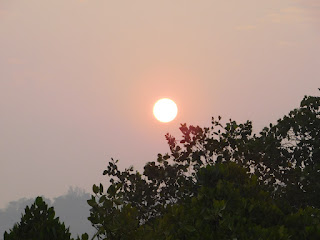


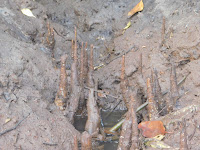


















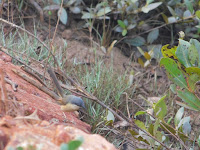




















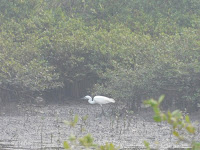












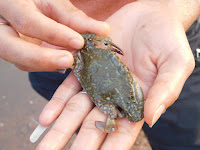


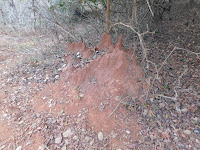




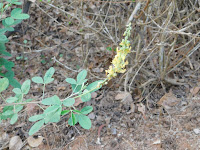




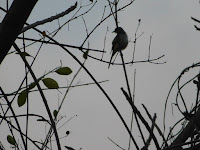





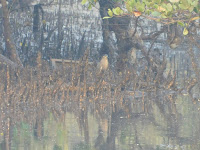

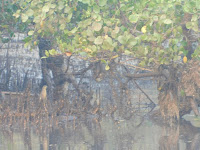



Comments
Post a Comment